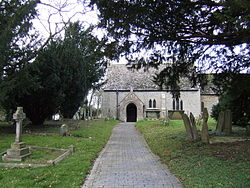Eaton Hastings
| Eaton Hastings | |
| Berkshire | |
|---|---|
 St Michael & All Angels parish church | |
| Location | |
| Grid reference: | SU260982 |
| Location: | 51°41’6"N, 1°37’16"W |
| Data | |
| Population: | 81 (2001[1]) |
| Post town: | Faringdon |
| Postcode: | SN7 |
| Dialling code: | 01367 |
| Local Government | |
| Council: | Vale of White Horse |
| Parliamentary constituency: |
Wantage |
Eaton Hastings is a village and parish beside the River Thames in Berkshire, adjacent to the borders with Oxfordshire and Gloucestershire. The village is about two and a half miles north-west of Faringdon. Eaton Hastings was formerly considerably larger than it is today, and is regarded as a deserted mediæval village.[2]
History
The original village developed around the parish church. Today all that remains are a few scattered dwellings and the church. The population started to decline after 1349, until by the 19th century it consisted only of a few scattered farmhouses.[3] The depopulation has been attributed to bubonic plague,[4] emparking[2] and sheep farming.[5] Late in the 19th century a group of houses was built on the Lechlade to Faringdon road, designed by the architect Ernest George for Alexander Henderson, 1st Baron Faringdon as part of a social improvement project. Many people now regard this as being Eaton Hastings,[3] but the remaining buildings of the original settlement are down a single lane road and not visible from the main road.
Parish church
The Church of England parish church of Saint Michael and All Angels is the most prominent surviving building of the original settlement. The earliest parts of the church date from the 11th century. It is constructed of rubblestone and consists of a simple nave, chancel and bellcote. The chancel largely dates from the 13th century. Between 1870-73 the church underwent Victorian restoration.[6]
The west window has stained glass depicting archangels Michael, Raphael and Gabriel. The window was installed in 1935 by Morris & Co. The designs date from 1860 and were created by William Morris and Ford Madox Brown. The north side of the chancel contains another Morris & Co. stained-glass window depicting St Matthew. This was installed in 1872–74, having been designed by Edward Burne-Jones.[6]
Alexander Henderson, 1st Baron Faringdon is buried in the churchyard; the angel on his tomb was sculpted by George Frampton. Next to the church is the former rectory, which dates from the 19th century.[5]
References
- ↑ "Area selected: Vale of White Horse (Non-Metropolitan District)". Neighbourhood Statistics: Full Dataset View. Office for National Statistics. http://neighbourhood.statistics.gov.uk/dissemination/viewFullDataset.do?instanceSelection=03070&productId=779&$ph=60_61&datasetInstanceId=3070&startColumn=1&numberOfColumns=4&containerAreaId=790499. Retrieved 30 March 2010.
- ↑ 2.0 2.1 Berkshirehistory.com
- ↑ 3.0 3.1 National Trust
- ↑ royal historical society bibliography
- ↑ 5.0 5.1 The Badbury Parishes Trail by Ian Beckwith 2001
- ↑ 6.0 6.1 thames.me.uk
Further reading
- Page, W.H.; Ditchfield, P.H., eds (1924). A History of the County of Berkshire, Volume 4. Victoria County History. pp. 528–531.
- Pevsner, Nikolaus (1966). Berkshire. The Buildings of England. Harmondsworth: Penguin Books. pp. 135–136.